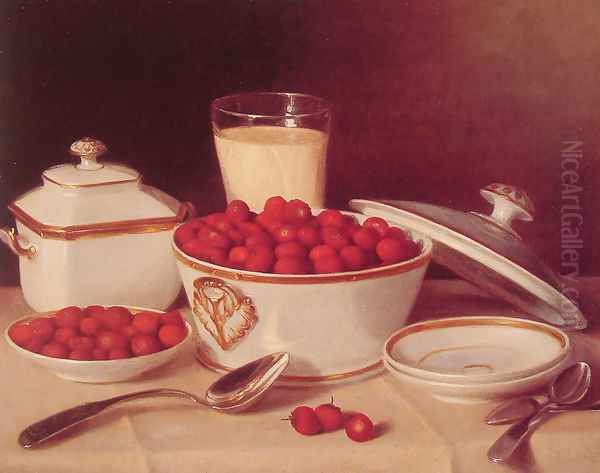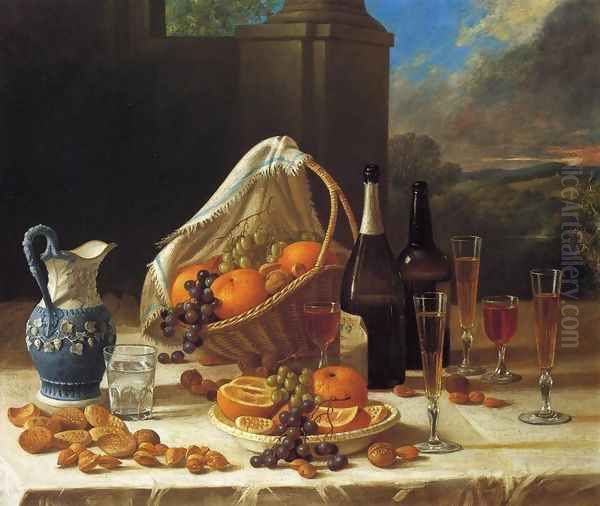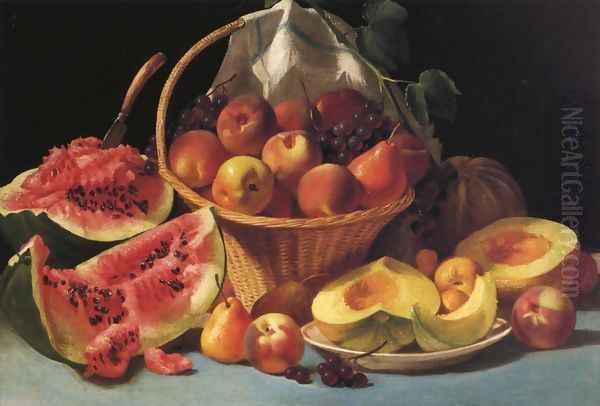John F. Francis stands as a significant, if for a time overlooked, figure in the landscape of nineteenth-century American art. Primarily celebrated for his luscious and detailed still-life paintings, particularly those depicting bountiful luncheon and dessert spreads, Francis carved a distinct niche for himself. His work, characterized by a rich palette, meticulous attention to texture, and a palpable sense of Victorian era abundance, offers a fascinating window into the tastes and material culture of his time. While he began his career as a portraitist, it was in the realm of still life that Francis found his most enduring voice, contributing a unique chapter to this genre in America.
Early Life and Artistic Formation in Philadelphia
Born in Philadelphia, Pennsylvania, in 1808, John F. Francis emerged as an artist in a city that was then a vibrant cultural and artistic hub in the young United States. Philadelphia, home to the influential Peale family of artists and the prestigious Pennsylvania Academy of the Fine Arts, provided a fertile ground for aspiring painters. While detailed records of his earliest training are somewhat scarce, it is known that Francis began his artistic journey primarily as a portrait painter. This was a common path for artists of the period, as portraiture offered more consistent opportunities for commissions and financial stability than other genres.
During the 1830s and 1840s, Francis established himself as a capable itinerant portraitist, traveling through various parts of Pennsylvania, Delaware, Tennessee, and Kentucky to capture the likenesses of local dignitaries, families, and individuals. His portrait style was generally straightforward and competent, reflecting the prevailing tastes for clear representation. Artists like Thomas Sully, a dominant figure in Philadelphia portraiture, would have been a significant presence in the artistic environment Francis navigated, though Francis's own portrait work tended to be less romanticized and more direct than Sully's. Other portraitists of the era, such as Henry Inman and Charles Loring Elliott, also contributed to the broad field in which Francis initially worked.
The Pivotal Shift to Still Life

Around the mid-1840s, a notable shift occurred in John F. Francis's artistic focus. While he continued to accept portrait commissions throughout his career, he began to dedicate increasing energy and talent to still-life painting. This transition marked the beginning of the period for which he is best remembered. The reasons for this shift are not definitively documented but could have been influenced by a personal artistic inclination, changing market demands, or the desire to explore a genre that allowed for greater compositional and technical freedom.
Philadelphia had a strong tradition of still-life painting, most famously established by Raphaelle Peale, son of Charles Willson Peale. Raphaelle Peale is widely considered America's first professional still-life painter, and his refined, subtly arranged compositions of fruit, vegetables, and tabletop items set a high standard. Francis was undoubtedly aware of this legacy, and his work can be seen as an extension and, in some ways, a more opulent interpretation of the Peale tradition. Unlike the often spare and contemplative arrangements of Raphaelle Peale, Francis's still lifes frequently exuded a sense of plenty and indulgence. His uncle, James Peale, and cousin, Sarah Miriam Peale, also contributed significantly to the still-life genre, further embedding this artistic practice within the Philadelphia school.
Hallmarks of Francis's Still-Life Paintings
John F. Francis developed a distinctive style in his still-life works, particularly renowned for his "luncheon" and "dessert" pieces. These paintings typically feature tables laden with an appealing array of food and drink: glistening fruits like grapes, peaches, and berries; decadent cakes, pies, and pastries; nuts, crackers, and cheese; and often bottles of wine or champagne, their glass surfaces reflecting the light. His compositions are usually generous, filling the canvas with a variety of textures, colors, and forms that invite the viewer to a sensory feast.
A key characteristic of Francis's still lifes is his meticulous rendering of detail. He paid close attention to the specific textures of different foods – the soft bloom on a grape, the crumbly surface of a cake, the smooth sheen of a wine glass. This verisimilitude was highly valued in the nineteenth century. His use of color was rich and warm, often employing a harmonious palette that enhanced the appeal of the depicted edibles. The play of light across the objects was another area of focus, creating highlights and shadows that gave volume and realism to the arrangements.

Unlike some of his European predecessors, such as the Dutch Golden Age masters like Willem Claesz. Heda or Pieter Claesz, whose still lifes often carried complex vanitas symbolism (reminders of life's transience), Francis's works generally celebrate material comfort and the pleasures of the table. They reflect a Victorian sensibility that appreciated abundance and domestic well-being. While not overtly symbolic in the vanitas tradition, these paintings spoke to the prosperity and aspirations of his contemporary American audience.
Notable Works and Thematic Concerns
Throughout his mature period, from the 1850s through the 1870s, Francis produced a consistent body of still-life work that solidified his reputation. While specific titles can vary or be descriptive, his oeuvre includes numerous paintings that can be broadly categorized.
Luncheon Pieces: These works often depict a midday meal setting, perhaps slightly informal but always abundant. One might find arrangements of bread, cheese, fruit, and perhaps a decanter of wine. Luncheon Still Life (various versions exist) typically showcases his skill in arranging diverse elements into a pleasing whole, balancing colors and textures effectively. The gleam of silverware, the transparency of glass, and the varied surfaces of foodstuffs are rendered with care.
Dessert Pieces: Perhaps his most iconic works, these paintings focus on the sweet conclusion to a meal. Still Life with Wine, Cakes, and Fruit or Dessert Still Life are common themes. Here, Francis would revel in depicting elaborate cakes, often multi-tiered or adorned with frosting, alongside bowls of fresh berries, nuts, and sparkling glassware. These paintings are a testament to the Victorian love for elaborate desserts and the social rituals surrounding them. Works like Strawberries and Cream highlight simpler pleasures but are rendered with the same attention to appetizing detail.
Fruit Compositions: While often part of larger luncheon or dessert scenes, Francis also painted compositions focusing solely on fruit. Three Watermelons, for instance, is a powerful study in form and color, showcasing the rich red interior of the cut melon against its green rind. These works demonstrate his ability to capture the natural beauty and inherent appeal of fresh produce.
His compositions, while detailed, were generally less about trompe-l'œil illusionism, a style that would later be famously pursued by artists like William Michael Harnett and John Frederick Peto. Instead, Francis aimed for a convincing and inviting realism that celebrated the objects themselves rather than trying to deceive the eye into believing they were real.
Exhibitions, Recognition, and Artistic Context

John F. Francis actively exhibited his work, primarily at the Pennsylvania Academy of the Fine Arts in Philadelphia and the National Academy of Design in New York. These institutions were central to the American art world, and regular exhibition there provided artists with visibility and opportunities for patronage. His still lifes were generally well-received during his lifetime, appreciated for their technical skill and appealing subject matter.
He was a contemporary of the Hudson River School painters, such as Thomas Cole, Asher B. Durand, and Frederic Edwin Church, who were achieving great fame for their majestic landscapes. While landscape painting dominated much of the discourse in American art at the time, still life maintained a steady, if quieter, presence. Francis, along with other still-life specialists like the German-American painter Severin Roesen, whose style was even more opulent and profuse, catered to a clientele that appreciated the genre's domestic scale and focus on everyday pleasures. Martin Johnson Heade, though renowned for his landscapes and hummingbird studies, also produced exquisite floral still lifes, contributing to the diversity of the genre.
The mid-nineteenth century saw a flourishing of still-life painting in America, and Francis was a leading practitioner. His work can be compared to that of George Henry Hall, another contemporary who specialized in fruit and flower still lifes, often with a similarly rich and detailed approach. The enduring appeal of Francis's paintings lies in their combination of skilled execution and their reflection of a particular cultural moment – one that valued domesticity, hospitality, and the tangible evidence of prosperity.
Later Career and Rediscovery
John F. Francis continued to paint into the 1870s, but like many artists of his generation whose styles were rooted in mid-century realism, his work gradually fell out of fashion as new artistic movements, such as Impressionism (though its impact in America was later), began to emerge. After his death in Jeffersonville, Pennsylvania, in 1886, his reputation faded, and he became a relatively obscure figure for several decades.
The twentieth century, however, brought a renewed scholarly and curatorial interest in earlier American art. Art historians began to re-evaluate the contributions of artists like Francis, recognizing the quality and significance of their work within the broader narrative of American art history. His paintings were "rediscovered," and he regained his place as one of the foremost American still-life painters of the nineteenth century. Today, his works are held in numerous prestigious museum collections across the United States, including the Metropolitan Museum of Art in New York, the Museum of Fine Arts, Boston, and the National Gallery of Art in Washington, D.C.
The art market has also recognized his importance, with his paintings achieving significant prices at auction, reflecting their desirability among collectors of American art. His appeal endures, not only for the aesthetic pleasure his works provide but also for the glimpse they offer into the material culture and social customs of nineteenth-century America.
Francis's Enduring Legacy
John F. Francis's legacy is that of a dedicated and highly skilled painter who excelled in capturing the bounty and beauty of the everyday, particularly the pleasures of the table. He built upon the foundations laid by the Peale family in Philadelphia, developing a more lush and celebratory style of still life that resonated with the Victorian era's appreciation for abundance. While his initial career as a portraitist provided him with a solid technical grounding, his true artistic passion and most significant contributions lay in the realm of still life.
His meticulous attention to detail, his rich use of color, and his ability to create inviting and harmonious compositions distinguish his work. He stands apart from the more austere still lifes of some of his predecessors and the later trompe-l'œil school, occupying a unique space characterized by a warm, accessible realism. His paintings are more than mere depictions of food; they are evocations of hospitality, comfort, and the quiet enjoyment of life's pleasures.
In the grand tapestry of American art, John F. Francis may not have sought the epic scale of the landscape painters or the dramatic flair of historical scenes, but his focused dedication to the still-life genre yielded a body of work that remains captivating and historically significant. He reminds us that beauty and artistry can be found in the familiar, and his canvases continue to delight viewers with their timeless depiction of a well-laid table. His influence can be seen in the continuing tradition of realist still life, and his works serve as important documents of nineteenth-century American taste and artistic practice, standing alongside those of other key figures in the genre, from Raphaelle Peale to Severin Roesen and beyond, including later masters of the form like Emil Carlsen. The quiet dignity and sumptuous appeal of his paintings ensure John F. Francis a lasting place in the annals of American art history.